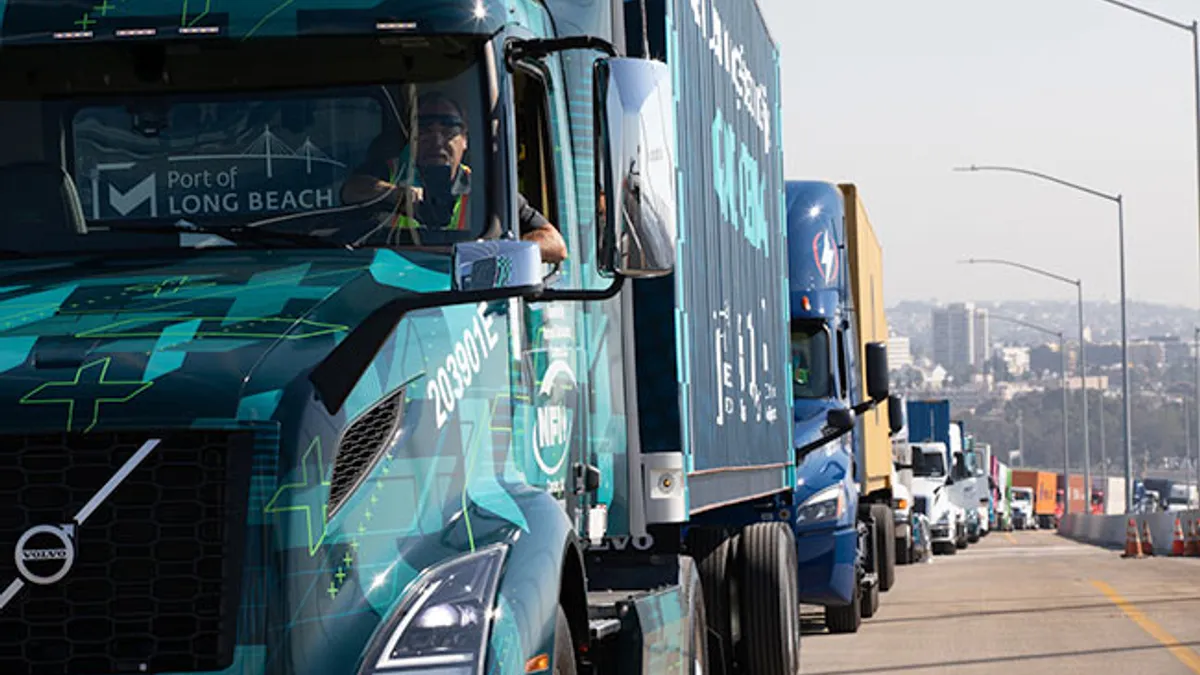UPDATE: Dec. 21, 2020: The California Public Utilities Commission (CPUC) on Thursday voted to approve a proposal creating a framework for vehicle-grid integration in the state, including using EVs to power buildings during wildfire-related public safety power shut-offs.
Commissioners also approved a commercial sector EV rate for San Diego Gas & Electric customers, as well as a proposal that would allow utilities to invest the money they get from selling Low Carbon Fuel Standard credits on electric vehicle projects.
“These decisions will advance California on its path toward a zero-emission transportation future,” CPUC Commissioner Clifford Rechtschaffen said in a statement.
Dive Brief:
-
The California Public Utilities Commission (CPUC) issued a proposal last week laying the foundation for the state's effort to better integrate electric vehicles (EVs) as grid resources, nearly two months after Gov. Gavin Newsom signed an executive order adopting a goal for all new passenger vehicles in the state to be zero-emission by 2035.
-
The proposed decision also contemplates the potential of using EVs as a way to power the grid during wildfire-related public safety power shut-offs, and would, if approved, instruct California utilities to report back on their plans for using vehicle-to-grid integration (VGI) as a resiliency measure.
- The proposed decision is the biggest tangible action that the CPUC has taken on VGI, Miles Muller, an attorney with the Natural Resources Defense Council's climate and clean energy program, said. "[T]he commission is recognizing that it's time to make VGI more than a theoretical proposition, so I think it's a good early action on that and hopefully sets off a wave of similar efforts in other states," Muller added.
Dive Insight:
As of August 2019, California had over 600,000 electric vehicles on the road, as well as 20,000 public charging ports, according to a report from Gridworks. That number is set to increase; Newsom's executive order, signed in the wake of several devastating wildfires that burned millions of acres in California this year, instructs the state's Air Resources Board to develop regulations mandating the zero-emission vehicles goal, which is estimated to reduce more than 35% of greenhouse gas emissions from cars in the state.
But experts say the order could also change the nature of California's load — one analysis from Energy Innovation suggests that staying on track to reach the goal could lead to a 9% increase in electricity demand by 2030 — and create the critical mass of EVs required to realize the VGI potential that the sector has been talking about for years.
VGI is capable of providing a broad suite of benefits to the grid — for instance, charging vehicles when there's excess solar on the grid, providing resiliency services and back-up power when the grid is down, and reducing demand or exporting power back on to the grid, Muller said.
"So I think it's going to be absolutely integral to transportation electrification going forward," he said.
In 2019, California lawmakers passed a bill requiring the CPUC to establish strategies and metrics to increase the integration of EVs into the grid by 2030, and the agency's new proposed decision lists some of those. This includes reforming retail rates, especially dynamic pricing structures — something that the commission is already reviewing for EV customers in Pacific Gas & Electric and San Diego Gas & Electric service territories.
The proposed decision, if approved by regulators, would also authorize utilities to propose vehicle-grid integration pilots, to prove that integration technologies can be scaled up and implemented in the real world.
Another potential strategy evaluated by the commission concerns designing wholesale market rules for vehicle-grid integration applications, and the proposed decision would instruct utilities to work with the California Independent System Operator and report back with possible updates. In addition, the proposal also looks at reforming interconnection rules to allow EVs to export power to the grid.
The commission also identified several near-term actions that "should be pursued as soon as possible," including instructing utilities to host a workshop in early 2021 with potential vehicle-grid integration demand response providers, and look into possible challenges that exist on that front.
Utilities would also be tasked with finding ways to deploy technologies to manage EV charging load as part of their transportation electrification program applications, with an eye to using EVs to reduce congestion on the distribution grid and avoid expensive physical upgrades to the system.
But there are multiple challenges in integrating vehicles with the grid, as the Gridworks report notes — there's little understanding around the costs involved, as well as the ability to actually engage customers.
"In a way, part of the difficulty is that VGI encompasses so much, so there's no one silver bullet to make [it] a reality," Muller said. Instead, it requires a number of different policies or refinements to existing policies, investments in new technologies and customer familiarity, Muller added.
The proposal, if approved, will eventually allow California to test the marketplace and determine what it's going to take for people to participate in VGI programs, what incentives should be involved, and what back office systems utilities need to develop, according to Mauro Dresti, senior advisor of transportation electrification (eMobility) technology strategy at Southern California Edison.
"I think the biggest challenge is trying to figure out what the incentives should be for the customers, and to get them to participate," Dresti said.















